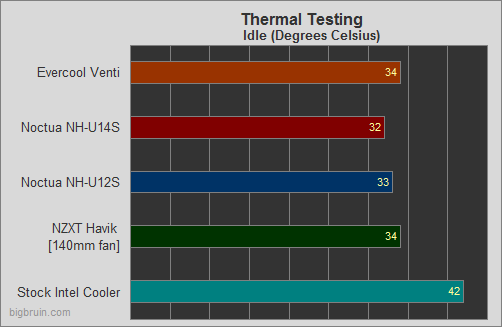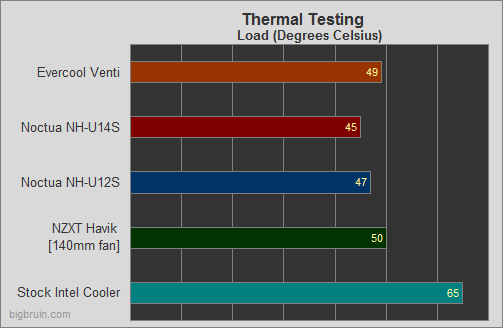Testing:
To test the performance of the
Evercool Venti cooler it was compared head-to-head with a handful of other coolers on an Intel Core i3 3225, installed in the system shown on the previous page. The stock Intel cooler, NZXT Havik 140, Noctua NH-U12S, and NH-U14S were all put up against the Venti. All fans were run at their default speed, without the used of any speed controlling devices.
Idle testing consisted of letting the system sit at the Windows 7 desktop with no other applications running for a period of 30 minutes. Load testing consisted of running 3DMark Vantage back-to-back three times. HWMonitor 1.19 was used to monitor idle and load temperatures, and the room was maintained at a consistent 22 degrees Celsius.
The chart below shows that each of the heatpipe coolers could get the processor down in to the low 30 degree range while at idle. 34C is the best the Evercool Venti could do, which is just a degree or two off of the top results put up by a pair of Noctua's coolers.

The next chart shows the load testing results, where the two Noctua coolers take the win, while the Evercool Venti beats out the NZXT Havik by 1 degree. The cooling performance of the Venti is definitely good, and I was actually surprised it could compete with these more substantial (and more expensive) coolers.

What the charts above can not detail is that while cooling almost as good as some higher end coolers, the noise produced was definitely more noticeable. The Noctua coolers are close to silent, but the same can not be said of the Venti. It has a drone to it that will be noticeable, most likely even with a case side panel installed. Slowing the speed down will reduce the noise and make it less noticeable, but the temperatures will surely go up. This definitely isn't the loudest cooler I have used, but I suppose I have become spoiled by the use of Noctua coolers/fans.